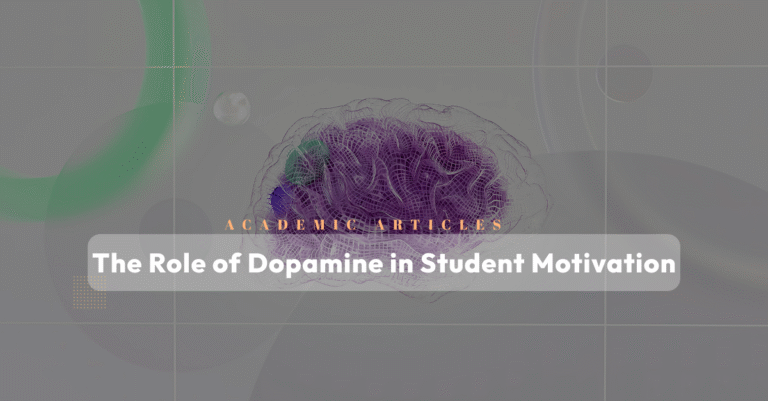Dopamine, a neurotransmitter often called the brain’s “motivation chemical”, plays a crucial role in how students engage with learning.
When students anticipate or receive rewards, dopamine levels rise, reinforcing behaviors that produce positive outcomes. This neurological mechanism is especially relevant in today’s online K‑12 classrooms that embed gamification into their design.
Dopamine and Motivation: The Neuroscience Basics
Dopamine functions within the brain’s mesolimbic and mesocortical pathways, originating in the ventral tegmental area (VTA) and projecting to regions like the nucleus accumbens and prefrontal cortex. It not only generates a sense of pleasure but also signals reward prediction error, adjusting motivation based on whether outcomes meet, exceed, or fall short of expectations.
Student Engagement in Online K‑12 Classrooms
Some online K‑12 environments that do not provide students with tutor instruction have unique engagement challenges: isolation, passive content delivery, and limited social interaction.
Gamification has emerged as a key strategy to overcome these obstacles. Elements such as progress bars, leaderboards, badges, and missions create immediate and visible feedback loops that stimulate dopamine release and maintain student attention.
Research indicates that gamified online classrooms lead to improved attendance, greater participation, and enhanced retention of content, all driven by reward-driven dopamine pathways.
Gamified Reward Systems: How They Stimulate Dopamine and Drive Behavior
There are multiple ways to simulate this type of behaviour.
Reward Mechanics

These can be:
- Points and Badges: Each accomplishment triggers a dopamine release, reinforcing motivation.
- Leaderboards and Competition: Social comparison amplifies the incentive to “win,” fueling further effort.
- Progress Bars and Unlocking Content: Observable advancement encourages persistence.
Dopamine Anchoring
This technique involves pairing an enjoyable stimulus (like music or short reward breaks) with less attractive tasks.
Over time, anticipating even a simple reward triggers dopamine release, making students more likely to begin and continue effortful work. Researchers call this “dopamine anchoring.” While effective, experts caution against over-reliance on extrinsic items, which can undermine long-term motivation.
Novelty and Adaptation
Initial engagement may spike once gamification is introduced, but this spike can fade due to the novelty effect. Studies show engagement often dips after a few weeks unless gamified experiences evolve or adapt. Platforms that refresh content, vary challenges, or personalize tasks tend to sustain motivation longer.
The Balance: Extrinsic vs. Intrinsic Motivation
Gamification primarily provides external (extrinsic) rewards, but it can also support internal (intrinsic) motivation when designed with self-determination in mind: competence, autonomy, and relatedness.
However, too much focus on external rewards (badges, leaderboards) may crowd out intrinsic motivation, especially if students come to expect incentives for all tasks. Thoughtful design, with meaningful challenges and personal choice, helps preserve student autonomy and intrinsic interest.
Potential Pitfalls and Ethical Considerations
Gamification Overuse and Misuse
Some studies found that excessive focus on points and ranking can distract learners from real learning goals. Known as gamification misuse, this effect can lead students to prioritize earning rewards over absorbing material, potentially undermining educational outcomes.
Diminishing Returns
As dopamine responses adapt over time, reward anticipation gradually diminishes. That’s why sustainable gamified designs rely on variable reinforcement schedules (like occasional surprise rewards) and periodic feature updates to maintain psychological effectiveness.
Individual Differences
Not all students respond equally. Personality traits (like competitiveness or need for collaboration) and prior gaming experience influence how effective gamification is for each learner. Adaptive platforms that tailor to individual traits perform better over time.
Conclusion
Gamified online K‑12 classrooms harness the power of dopamine to enhance student motivation and engagement. By structuring learning with incremental rewards, progress visibility, social interaction, and adaptive challenges, educators can create a positive loop: students feel good about learning, dopamine reinforces engagement, and learning becomes more self-perpetuating.
However, to be sustainable, gamified systems must:
- balance extrinsic and intrinsic motivation;
- avoid overemphasis on superficial rewards;
- evolve over time to counter novelty fatigue;
- Accommodate individual learner differences.
When implemented thoughtfully, gamification, rooted in our understanding of dopamine and reward psychology, becomes more than just a game: it becomes a motivational scaffold that supports meaningful, enduring learning.
Share, Discuss, or Ask
Do you have a child in an online school, or are you considering enrolling your child in one? We’d love to hear about your experiences. Let us know what has been or may be decisive in the dilemma of Traditional vs. Online.
If you have questions, please visit us at EduWW or email [email protected].



